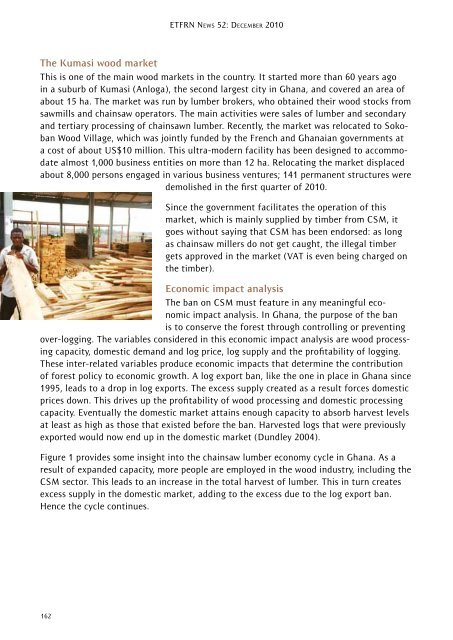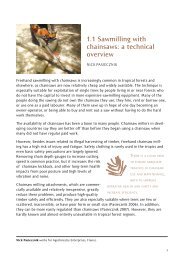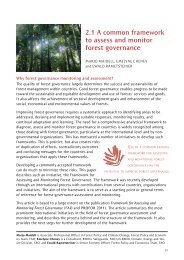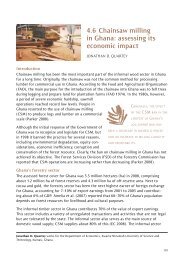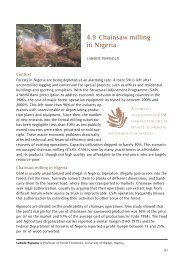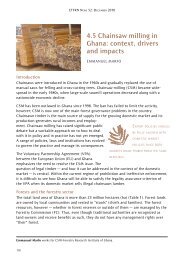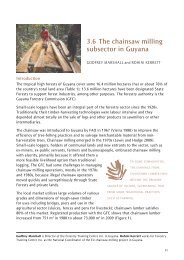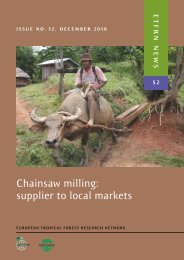Chainsaw milling: supplier to local markets - European Tropical ...
Chainsaw milling: supplier to local markets - European Tropical ...
Chainsaw milling: supplier to local markets - European Tropical ...
Create successful ePaper yourself
Turn your PDF publications into a flip-book with our unique Google optimized e-Paper software.
162<br />
ETFRN NEws 52: DEcEmbER 2010<br />
The kumasi wood market<br />
This is one of the main wood <strong>markets</strong> in the country. it started more than 60 years ago<br />
in a suburb of kumasi (anloga), the second largest city in Ghana, and covered an area of<br />
about 15 ha. The market was run by lumber brokers, who obtained their wood s<strong>to</strong>cks from<br />
sawmills and chainsaw opera<strong>to</strong>rs. The main activities were sales of lumber and secondary<br />
and tertiary processing of chainsawn lumber. recently, the market was relocated <strong>to</strong> sokoban<br />
wood Village, which was jointly funded by the French and Ghanaian governments at<br />
a cost of about us$10 million. This ultra-modern facility has been designed <strong>to</strong> accommodate<br />
almost 1,000 business entities on more than 12 ha. relocating the market displaced<br />
about 8,000 persons engaged in various business ventures; 141 permanent structures were<br />
demolished in the first quarter of 2010.<br />
since the government facilitates the operation of this<br />
market, which is mainly supplied by timber from Csm, it<br />
goes without saying that Csm has been endorsed: as long<br />
as chainsaw millers do not get caught, the illegal timber<br />
gets approved in the market (VaT is even being charged on<br />
the timber).<br />
Economic impact analysis<br />
The ban on Csm must feature in any meaningful economic<br />
impact analysis. in Ghana, the purpose of the ban<br />
is <strong>to</strong> conserve the forest through controlling or preventing<br />
over-logging. The variables considered in this economic impact analysis are wood processing<br />
capacity, domestic demand and log price, log supply and the profitability of logging.<br />
These inter-related variables produce economic impacts that determine the contribution<br />
of forest policy <strong>to</strong> economic growth. a log export ban, like the one in place in Ghana since<br />
1995, leads <strong>to</strong> a drop in log exports. The excess supply created as a result forces domestic<br />
prices down. This drives up the profitability of wood processing and domestic processing<br />
capacity. Eventually the domestic market attains enough capacity <strong>to</strong> absorb harvest levels<br />
at least as high as those that existed before the ban. harvested logs that were previously<br />
exported would now end up in the domestic market (Dundley 2004).<br />
Figure 1 provides some insight in<strong>to</strong> the chainsaw lumber economy cycle in Ghana. as a<br />
result of expanded capacity, more people are employed in the wood industry, including the<br />
Csm sec<strong>to</strong>r. This leads <strong>to</strong> an increase in the <strong>to</strong>tal harvest of lumber. This in turn creates<br />
excess supply in the domestic market, adding <strong>to</strong> the excess due <strong>to</strong> the log export ban.<br />
hence the cycle continues.


